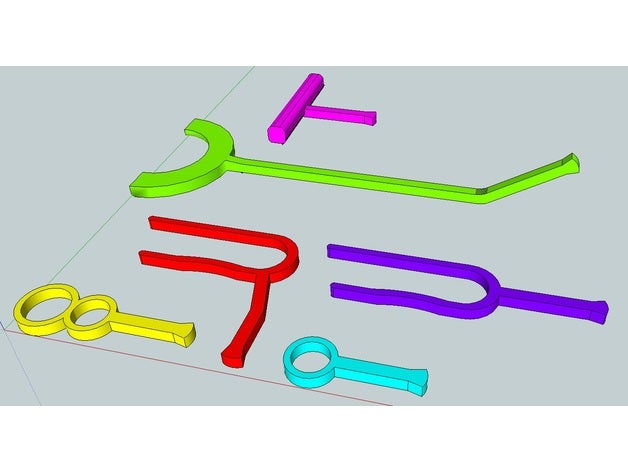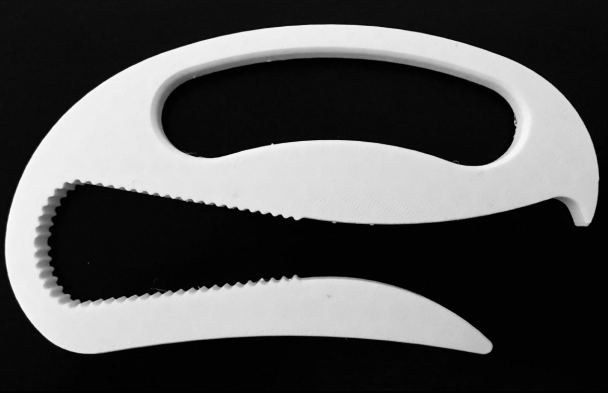Amber K. Willett has submitted a thesis to the Department of Occupational Science and Occupational Therapy at Eastern Kentucky University, exploring the potential for 3D printers as a tool for occupational therapists in ‘3D Printing and Occupational Therapy: The Process of 3D Printing Adaptive Devices.’ As 3D printing becomes widely embraced in the medical field, a range of hardware, software, and materials are being used by researchers and medical technicians around the world.
With the goal of offering patients a better quality of life—and even in some cases, saving their lives, doctors and health care practitioners of all kinds are using 3D printers today to create 3D printed models and devices, as well as continuing to innovate in areas like dentistry, prosthetics, tissue engineering, and much more.
The benefits are compelling, beginning with affordability and accessibility, both of which just continue to improve—and on many different user levels. Speed is often a huge factor too as items like prosthetic arms or orthotics for shoes can be created in just hours (rather than weeks) and can be completely customized to the patient.
For occupational therapy, however, 3D printing so far has been used to make a variety of different splints; for example, burn patients have received finger splints that may be cheaper to make but still offer good or better performance, as well.
Even more importantly, such devices can be fitted in a completely patient-specific manner—often allowing the choice of everything from the 3D printer to the best software, materials, and choice of parameters and settings. Savvy users around the world are also benefiting from a growing open-source community which allows for greater sharing and innovation, as well as attention to the needs of patients.
“Compliance of braces is an important factor in the healing and recovery of patients. Poor adherence to the treatment regimen could occur as a result of a number of factors related to the splint, such as uncomfortable fit and difficulty removing the splint,” states Willett. “3D printed splints have many benefits that make them ideal to use with patients, such as comfort and fit, proper ventilation, lightweight, and aesthetic features.”
Willett also discusses prices, being realistic about the expense of high-performing industrial printers yet encouraged over costs and features offered at beginner levels. For this study, the research team used a FlashForge Finder, ordered from Amazon for only $349, featuring a 5.5 x 5.5 x 5.5 print area, FlashPrint as the software, and PLA as the recommended material.
“Compared to the cost of commercially available devices, it is more cost effective to use a 3D printer to create the device. Overall, it was not that expensive to run the 3D printer and create these devices,” stated Willett.
Twelve designs were created as Willett navigated the learning curve involved in the set-up, downloading files, considering the need for supports, and ‘other adjustments’ such as ‘layer height, shells, infill, speed, and temperature.’

Keyboard designs from Thingiverse
Five samples for the study were adaptive keyboard devices mean for individuals experiencing ‘limited hand or wrist movement,’ along with two bottle openers to help those with arthritis, three pen holders, and a key turner to assist in the case of difficulty with motor skills or wrist strength. Last, Willett created a signature guide to help those in need write their names more easily.
Ultimately, the benefits discovered during the study were as follows:
- Devices can be created ‘in a timely manner.’
- Prints are cheaper to make than buy.
- Customization offers more options, and comfort, for clients.
- Printers offering the use of multiple filaments create great potential in health care (that was not the case here as only PLA could be used; however, Willett realized the opportunity otherwise).

Bottle opener 1 from Thingiverse

Pen holder device from Thingiverse
Some limitations were noted also, in relation to 3D printing for occupational therapy, beginning with the drawbacks to a smaller print area and the use of only one filament—prohibiting a wide range of devices from being made. Training is required, and there are numerous complications that can occur, from clogging to issues with warping, cracking, missing layers, and more.
“After completing this project, it can be determined that it is fairly easy to buy an entry-level, low cost printer and adapt its use in a therapy setting,” concluded Willett. “Aside from using a printer to print adaptive devices, it can also be used for splints or as an activity with a client. There were minimal complications using the FlashForge Finder and it was easy to set-up and start printing.
“Due to the availability of device patterns on the internet, it is easy to find devices that can be used by the clients. In the future, more research needs to be conducted on how to create devices using modeling software and further uses of 3D printing with an application in occupational therapy.”
What do you think of this news? Let us know your thoughts! Join the discussion of this and other 3D printing topics at 3DPrintBoard.com.
[Source / Images: ‘3D Printing and Occupational Therapy: The Process of 3D Printing Adaptive Devices’]
Subscribe to Our Email Newsletter
Stay up-to-date on all the latest news from the 3D printing industry and receive information and offers from third party vendors.
You May Also Like
3D Printing News Unpeeled: A $3000 SLS System, Construction Subsidies and Parameters
The Housing Affordability Crisis is one of Canadian President Trudeau’s biggest issues. Now the government has made subsidies available, including scaling new technologies, 3D printed housing and libraries of reapproved...
“Bundled Light” Enables High Quality Plastic 3D Printing from LEAM
Naturally, we expect current 3D printing methods to continuously improve, but it continues to do so in the most surprising ways. The latest development comes from LEAM, a startup spun...
Each to Their Own: Exploring Creality’s Latest Ender Trio as the Company Strengthens Its Commitment to 3D Printing Advocacy
Creality has reaffirmed its commitment to promoting 3D printing. The launch of the Ender-3 V3 SE, Ender-3 V3 KE, and Ender-3 V3 showcases the company’s dedication to catering to diverse...
3D Printing News Briefs, March 23, 2024: AM in the US Coast Guard, Navy, & More
In today’s 3D Printing News Briefs, we’re discussing the use of 3D printing in various branches of the military, including the U.S. Coast Guard, the U.S. Navy, and the German...
































